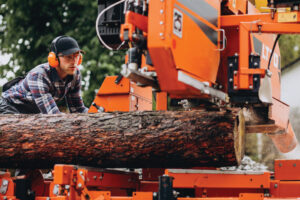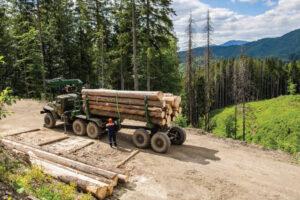Growth in the Mountain State
By Samantha Cart

While many associate the Mountain State solely with the energy industry, its nickname conjures up a different image. West Virginia’s beautiful, forested mountains make it the second-leading hardwood state in the country, ranked third nationally by percentage of forested land. The forest products industry—which is made up of loggers, sawmills, dry kilns, veneer plants and furniture and rustic rail fence producers—generates $3.2 billion for the state economy every year and employs more than 30,000 people in highly skilled and technical positions. Companies such as AHF Products, Gat Creek, Weyerhaeuser and Columbia Forest Products, among others, make use of the state’s 12 million acres of forestland and 75 billion board feet of timber inventory in an industry that reaches all 55 counties.
While forest products are a significant and successful revenue producer and employer for West Virginia based on renewable resources, the industry is not without its challenges. As with every sector, wood and timber companies were negatively impacted by the COVID-19 pandemic and subsequent workforce shortages, supply chain issues, construction delays, rising material costs and interest rates, as well as more recent international trade barriers.
While wood and timber companies in West Virginia were declared essential businesses by Governor Jim Justice at the onset of the pandemic, allowing them to continue operations, demand for their products fluctuated. While the industry saw new highs in the demand for lumber in 2021-2022, today’s lumber prices are at an all-time low, according to Joe McNeel, director of the Appalachian Hardwood Center.
“The last three years for the hardwood industry have seen dramatic highs and lows,” says Robbie Morris, executive director of the Randolph County Development Authority and member of the Hardwood Alliance Zone. “During the COVID-19 pandemic, many people decided to remodel their homes and businesses, which drove the need for flooring, moldings, oriented strand board (OSB), cabinets and similar products to record highs. This caused near record prices and demand for hardwoods. However, as inflation and the cost of capital have also seen dramatic increases, this has caused the hardwood market to significantly decline in the demand for raw and finished products. The hardwood industry is very dependent on the housing market. As we see reports of the housing market cooling off, that will cause the hardwood industry to cool as well. In addition, global uncertainty with countries like China and Russia is causing major issues with the export market.”
The demand for labor in every industry continues to drive up wages while the prices for raw and unfinished hardwood products decline. According to Morris, this has placed a significant burden on hardwood producers who lack the workforce necessary to operate.
“Many of the larger companies in Appalachia have started to focus on machinery and technology as substitutes for labor, since we seem to be constantly short of people,” adds McNeel.
Not without solutions, many of the state’s higher education institutions offer two and four-year degrees in forestry-related programs. The West Virginia Wood Technology Center has partnered with several organizations to provide training for various aspects of the hardwood industry. These partnerships include the Randolph County Housing Authority’s Get Ready and STRIVE programs, both of which train workers in hardwood machine operation, workplace safety and heavy equipment operation.
“The center also partners with the YouthBuild program and the Mountaineer ChalleNGe Academy to help prepare the workforce needed by hardwoods and related industries and the National Hardwood Lumber Association to provide lumber grading classes for individuals and businesses,” says Morris.
While the industry continues to maneuver through various challenges, there are also several clear growth and development opportunities. Not least among these is the fact that, according to Anthony Raines, president of Rainco Forest Resources, the state’s forests are growing faster than they are being harvested, at a rate of 2.2-1, making West Virginia a natural choice for current and future forest products companies.
Eric Carlson, executive director of the West Virginia Forestry Association, says the most recent analysis by the U.S. Forest Service suggests that West Virginia only harvests 23% of its annual forest growth.
“West Virginia is 78% forested and has many larger forest holdings, making access to the resource an advantage,” he says. “West Virginia is dominated by mature hardwood forests, meaning the trees are larger than other hardwood forests in the U.S., offering opportunities to harvest more high-quality hardwoods. The diversity of species also offers opportunities for many differing uses of the harvested hardwoods. Even when you include natural mortality of the forest, there is a net gain of 32% every year, meaning West Virginia can substantially increase the size of the industry and continue to sustainably grow the forest. This is very attractive to the forest products industry.”
This promise of expansion, sustainability and an already skilled workforce positions West Virginia as a critical provider of hardwoods as more and more companies focus on utilizing sustainable products. Carlson would also like to see more secondary and finish manufacturing investments and new products, as well as innovation in harvesting equipment, develop in the Mountain State.
“We have seen great cooperation with the state’s economic development team to date, but we also need private equity investment to modernize the entire supply chain,” he says. “Like many businesses, it takes years to recoup the initial investment, and market demand for products is crucial.”
Along with the existing production of OSB, hardwoods, laminated veneer lumber, flooring, furniture, cabinets, wood pellets, pallets, fencing and high-quality barrels for spirits, many consider cross-laminated timber (CLT) to be used in commercial and other construction the most well-researched market West Virginia is poised to break into.
“Europe has embraced this product for new construction and multistory building because it makes the construction process go quickly, has an appealing look, is energy efficient, has an exceptional fire rating and retains carbon during building,” Carlson says.
 McNeel says there is already a significant push by the hardwoods industry to approve yellow poplar as a suitable raw material for the production of CLT panels for commercial construction, making the market a close reality.
McNeel says there is already a significant push by the hardwoods industry to approve yellow poplar as a suitable raw material for the production of CLT panels for commercial construction, making the market a close reality.
“This could create significant potential for growth in many regions of West Virginia where yellow poplar is an abundant species,” he says.
Other potential ventures include wood nanoparticles, thermally modified lumber for decks and other outdoor uses, wood as biomass for energy production and the production of wood ethanol and its byproduct, biochar, as a soil additive in plant nurseries and greenhouses, which retains carbon in the landscape. High-quality biochar is being used in some parts of the world in the carbon metal manufacturing process, according to Carlson.
As the movement toward using environmentally friendly products gains more and more momentum, the use of hardwood products should increase with it.
“When a mature tree is harvested and made into products such as flooring, the carbon in that wood is trapped,” explains Morris. “Younger trees absorb more carbon than mature trees. Harvesting mature trees allows for younger trees to grow, absorbing more carbon, producing more oxygen and effectively cleaning the air. With managed forest practices, West Virginia has the opportunity to be a leading producer of sustainable hardwoods indefinitely.”
As state and federal leaders continue to discuss and develop laws and regulations regarding solutions to climate change, another potential opportunity—and challenge—for West Virginia’s forest products companies lies in navigating the carbon market and the impact of carbon credits.
As competition increases for alternative, non-renewable materials such as vinyl and plastics to be made into products that imitate real American hardwood, some companies may be considering entering into a carbon contract. Meant to decrease timber harvesting, companies and organizations offer carbon contracts to landowners in West Virginia. Forest owners can receive payment in exchange for leaving their forests untouched in an effort to accumulate as much carbon as possible.
“Landowners can, under some contracts, still harvest the annual growth off their forest, rather than roll it into the carbon contract, which allows the landowner to consider both markets when trying to maximize revenue off the site,” says McNeel.
As the Mountain State’s forest products companies chase new markets, invest in opportunities for growth and navigate the challenges of a post-pandemic world, the state’s abundant natural resources continue to provide beauty and promise in every corner of Almost Heaven.
Forest Carbon Credits
West Virginia Executive understands that in any industry, there are hot topics of conversation and opposing views to concepts and ideas. For the forest products industry, one of those topics is carbon credits. Below, Michael Haid, executive director of the West Virginia Land and Mineral Owners Association, shares his view in favor of carbon credits, while Anthony Raines, president of Rainco Forest Resources, shares his view in opposition of them.
IN FAVOR OF
By Michael Haid, West Virginia Land and Mineral Owners Association Executive Director
How will carbon affect timber and wood companies?
Beyond their primary goal as a mechanism for reducing the effects of climate change, forest carbon programs began to provide a funding stream to landowners between harvests. In West Virginia, a growth cycle might be between 50-60 years. Forest carbon programs allow you to get paid to regrow those forested lands. The most common forest carbon term length in West Virginia is 20-40 years, which aligns with growth cycles, ensuring that the owners have consistent revenue. Older-growth forests store more carbon, but younger trees absorb more carbon. When older trees are harvested, the lumber continues to store the absorbed carbon in wood products. Managed harvesting reduces the risk of wildfire, pests and disease, which can result in the release of carbon from the trees, and it improves the natural regeneration of trees. Additionally, using the Family Forest Carbon Program as an example, up to 25% of the property can be harvested ensuring sawmills have a consistent supply of timber.
What are the pros of carbon credits in West Virginia?
We believe individuals have certain private property rights. We’ve never pushed for any government mandate toward forest carbon programs as it’s all been left to the free market to decide. We think that allowing individual landowners to make responsible decisions about their property is a good thing. Each landowner should have the freedom to optimize their economic resources. The protection of property is a fundamental right valued by West Virginians. Regulating and taxing forest carbon agreements out of existence is anti-free market and an intrusion of government into private property rights and contracts. Landowners should be able to decide how to best utilize their property without government interference.
How do carbon credits impact the economy in West Virginia?
Forest carbon programs have the potential to be a tremendous boom to the economy of West Virginia. Many small to medium-sized landowners can leverage their forested lands to bring in additional income. That income stream can be enough to make needed improvements to the land, upgrade farming equipment and pay property taxes. Oftentimes, these plots of land have been in West Virginia families for generations, and with a tightening economy, it can be tempting to sell it to meet an immediate economic need. Now, rather than going that route, they can keep that land in the family by enrolling their property in a forest carbon program and generate much-needed, taxable income.
IN OPPOSITION OF
By Anthony Raines, Rainco Forest Resources President
How will carbon affect timber and wood companies?
Unfortunately, there has been a shift in carbon protocols and standards that are now pushing forest carbon projects toward a more preservationist arrangement that reduces timber harvesting. This is evident by the recent purchase of 703,000 acres of West Virginia timberland by Anew Climate, where the new owner has stated that harvests will be reduced by 70-80%.
Some are calling this new approach proforestation. The Sierra Club defines proforestation as, “extending protections so as to allow areas of previously logged forest to mature, removing vast amounts of atmospheric carbon and recovering their ecological and carbon storage potential.”
What are the cons of carbon credits in West Virginia?
If actual science was being followed, carbon could be of great benefit to our state. Unfortunately, the carbon industrial complex has the science backward when it comes to increasing carbon sequestration using forests with their hands-off approach to forest management. Products made from wood continue to store carbon throughout their useful life, while more trees are grown in their place, sequestering additional carbon from the air. When a forest is allowed to grow unmanaged, it eventually becomes a carbon source rather than a carbon sink.
Furthermore, the overwhelming consensus is clear that a hands-off preservationist approach to forest management will result in less healthy and fire-prone forests, not only in West Virginia, but across the U.S.
If the carbon companies truly wanted to increase carbon sequestration, they would be advocating for the increased use of renewable forest products instead of carbon-intensive, non-renewable materials such as concrete, steel and plastic. Increased demand for forest products would create immense economic opportunities for West Virginians and provide a much-needed economic stimulus to our local communities.
How do carbon credits impact the economy in West Virginia?
If forest carbon continues down its current path of harvest reductions and preservationist-style management, I’m afraid the effects will be costly for local communities that can least afford it. A large portion of our state’s privately owned timberland belongs to out-of-state corporations and investment funds. In the past, these lands have benefited West Virginians with jobs and opportunities in the natural resource industries, but with carbon, there is no job creation, no economic stimulus for our local communities. When an out-of-state corporation sells carbon offsets derived from their lands located in West Virginia to someone like Disney or Amazon, not a single dollar of that transaction enters our state’s economy.
Forest Family Dynasty
By Anna Moore
Wood isn’t just a product of work for some in the business. For the Hamer and Plaugher families, it’s a livelihood and a dynasty.
“I was born with sawdust in my veins, as was my father and others whose livelihood depended on this unique hardwood industry here in what I describe as one of the most thriving forests in the world—in the heart of Appalachian’s finest hardwood forest,” Steve Hamer says.
Hamer is among the fourth of five generations of Hamers in the forest products industry in West Virginia. His great-grandfather, John Hamer, worked at a logging camp in the early 1900s for a company called Prendergast where he met his wife, Sally, who was the camp cook. Their son, James Prendergast Hamer, later founded the J. P. Hamer Lumber Company, which grew to seven sawmills, two truck flooring plants and several dry kiln locations. J. P.’s son, James C. Hamer, worked for his father’s business before the lumber company was eventually sold. Three years later, the Jim C. Hamer Company was founded, and the company has been thriving since.
Today, Steve and his son, Stephen Hamer, continue to work alongside the family at Jim C. Hamer Co. Steve is the CEO and president of the company and the vice president of Hamer Pellet Fuel. While his career path may have been decided for him, Steve says he didn’t always want to work in the family business.
“It’s funny how things work out with me being the youngest of three kids and ending up making a career here in the family business,” he says. “I never thought that would happen, but I’m glad it did and feel so blessed to have had the opportunities afforded to me over the many years working in this unique industry.”
A similar inevitability happened to Tom Plaugher, vice president of operations for Allegheny Wood Products, Inc. When he started engineering school at West Virginia University (WVU) years ago, it didn’t take him long to realize he didn’t want to work in an office setting.
“I had to be outside,” he says. “I transferred to the WVU Forestry School pretty quickly.”
Working outdoors is what the Plaugher family has known for generations. With grandparents who farmed, worked on railroads and logged with horses, the family centered its life’s work on natural resources and the great outdoors.
“That early appreciation of natural resources and the family careers provide an understanding that it can be an enjoyable and bountiful career that continued the family legacy in natural resources,” says Aaron Plaugher, fiber sustainability manager for WestRock.
Aaron’s wife, Tina, works for an agriscience company while their daughter, Gillian, works in the dairy industry. Their son, Patrick, recently graduated with a forestry degree from WVU.
“Seeing my family’s successes and how they enjoyed their outdoor jobs made it seem like a good career decision,” Patrick says.
Tom and Aaron’s father, Eldon, spent 35 years with Westvaco Corporation, mostly as a land manager, before spending five years in Glenville State University’s Forest Technology Department. His wife, Linda, worked for the U.S. Forest Service for many years.
“My dad taught my brother and I about the practical application of forestry and silviculture on the ground,” Tom says. “We both knew how to use a compass and read a topographical map when we were very young. We had both laid out and cruised our first timber sale by the time we were 16.”
The Plaughers have a Christmas tree farm that Eldon and his wife started when they built their Parsons home, letting their boys help plant, mow around and cut the trees to learn how to properly care for nature.
“We have enjoyed the families coming with their small children and now some of those children are bringing their little ones to pick a tree,” Eldon says.
From developing Appalachian Wood Pellets to his wife’s farm in Tucker County to his extended family’s commitment to natural resources and agriculture, Tom Plaugher knows this line of work is his destiny.
“I can honestly say that in 30 years, I have never spent more than a couple of days in a row sitting behind a desk,” he says.






